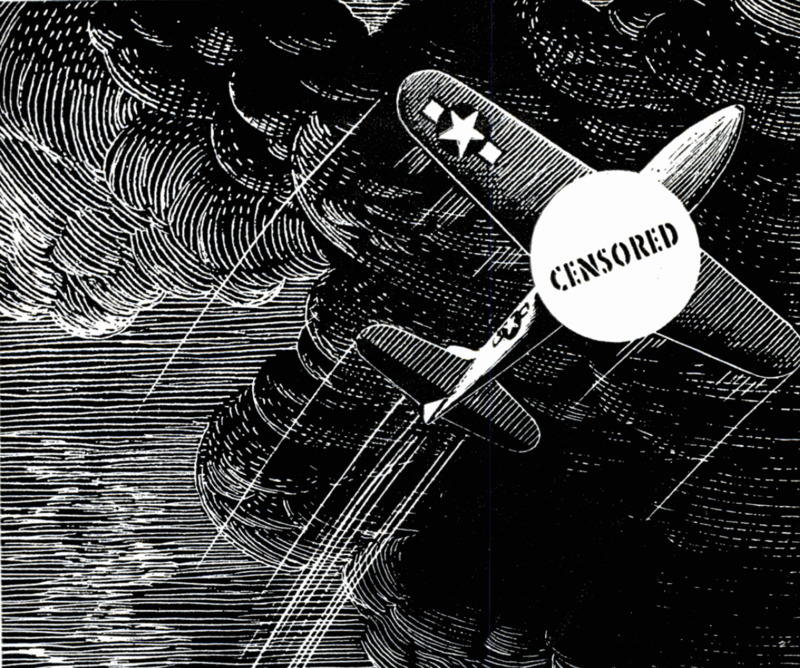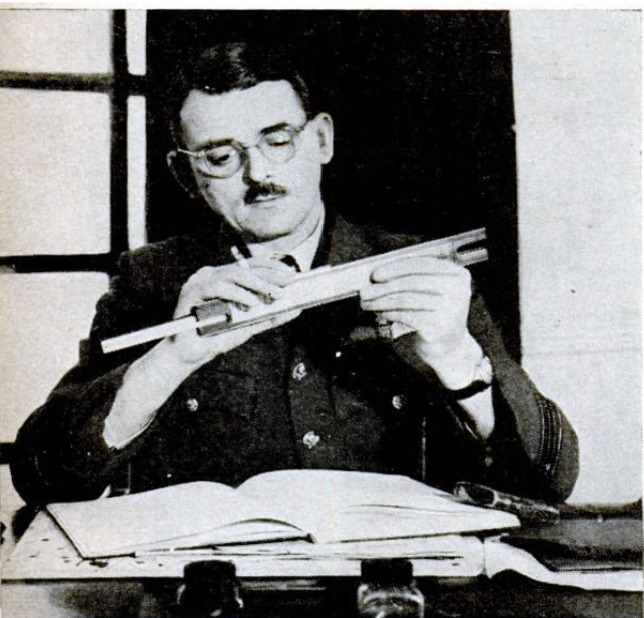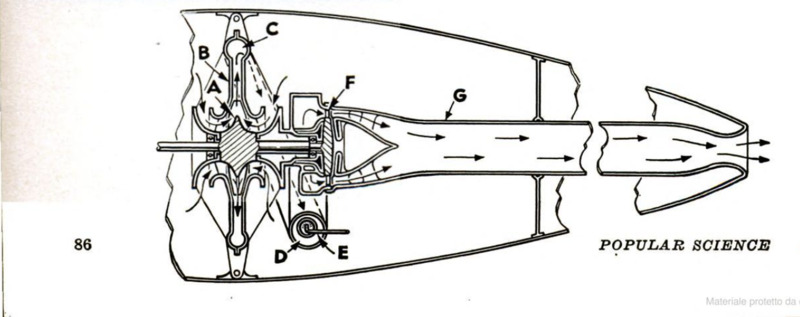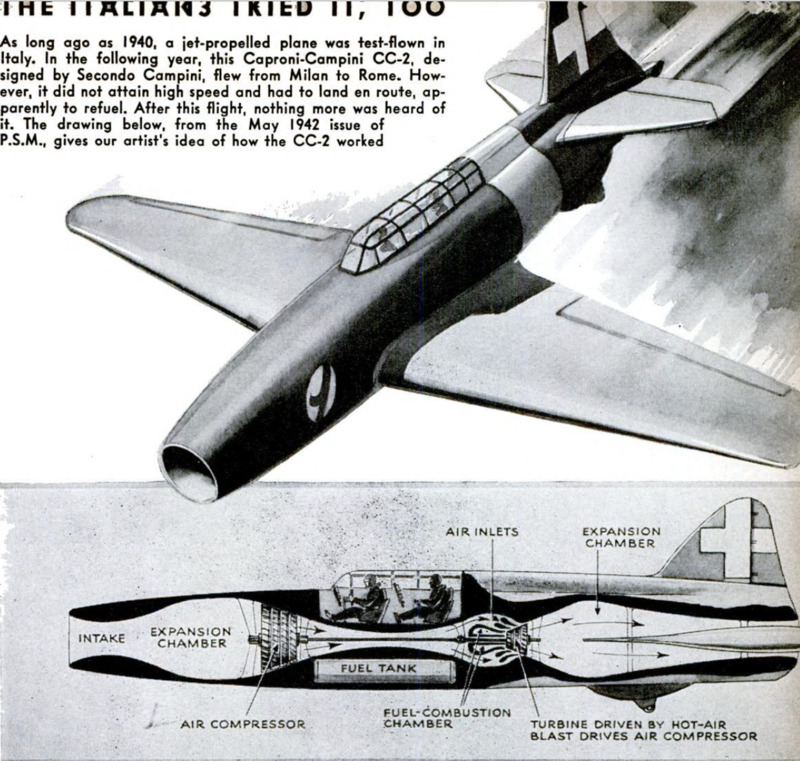-
Titolo
-
Bell jet-propelled plane
-
Article Title and/or Image Caption
-
Title: No supermen needed
-
Subtitle: Flying the new jet plane is as simple as handling a primary trainer, say pilots who have done it
-
extracted text
-
A oronmn of the Bell jet-
propelled plane has set off a train
of speculation as to what special train-
ing will be required by our pilots before
they can handle this new type of air-
craft in combat.
Jet-propelled aircraft — sometimes
erroneously called “rocket planes,” im-
mediately suggest to the layman flame-
trailing, bulletlike aircraft piloted by
supermen specially prepared for this
nerve-racking work after months of
conditioning and training on the
ground. Bunk!
Brig. Gen. C. W. Chidlaw, Chief of
the Army Air Forces Materiel Divi-
sion, after flying this amazing ship,
said: “Our pilots will find no trouble
in operating these planes.” Others who-
have flown it have made similar re-
ports.
Are they covering up real difficul-
ties ? Let's analyze what has been said
about this plane and what has been pub-
lished about jet propulsion, and see what
flying one of these ships must be like. |
The men who have looked forward to
Buck Rogers experiences in these craft will |
miss all the characteristics popularly asso-
ciated with so-called rocket flight. There is
no lurching, roaring, flame-trailing whizz; |
no vibration and straining of structures. |
‘Were powder rockets used as propellants
in the Bell aircraft, such things might be a
part of the picture, but this craft is pro-
pelled by a jet of air alone.
The engine, designed by Wing Commander
Frank Whittle of the RAF, was first used
successfully in a plane built for its use by
the Gloster Aircraft Company of England.
The engines used in the Bell plane are as-
sumed to be of similar design to Whittle's
early models, although all details are secret.
His unit designed in 1933 consisted of a
simple, compact air compressor into which
the atmosphere poured from the forward
end. After compression it was heated,
augmented by additional burning fuel (re-
ported in the press to be kerosene), and
finally discharged from the aft vent in a
monstrous jet of energy pushing against the
atmosphere. This backward push produced
the equivalent in forward thrust.
Full details of this engine were disclosed
to the U. S. Army Air Forces in July 1941.
The AAF at once asked for a specimen en-
gine for experimentation, and one was sent
to this country. It was turned over to the
General Electric Company, which worked
closely with our Matériel Command and
the Bell Aircraft Corporation to develop
the plane and engine that we now have.
And now about its flight:
Frank H. Kelley, Bell Aircraft Corpora-
tion test pilot says: “It is the smoothest
ride I have ever experienced in any plane.
The first time I climbed into the cockpit, T
was naturally a little nervous about first
contact with an entirely new method of
propulsion. My nervousness persisted while
I started the engines and until I began to
taxi across the fleld for take-off, when it
dawned on me that this plane was even
simpler to operate than a primary trainer.
I flew it through all maneuvers for 20 min-
utes, and then landed and taxied up to the
line,
“I wanted to check the fuel before resum-
ing flight, and so, before turning on the
main switch to read the electrical gauges, I
stuck my head out of the cockpit and
shouted to warn the mechanics to stay clear
of the propeller, completely forgetting that
I didn’t have any propeller.”
Let's see how all this can be—how one
can forget that there are no propellers, why
operation can be “even simpler than a pri-
mary trainer,” and why the outstanding
thing about this jet plane is its ease of op-
eration by pilots.
As seen in the illustration on page 85,
from a Bell announcement, the plane is of
almost conventional appearance except for
the absence of a propeller and the addition
of certain structural features to accommo-
date jets. Standard appearance indicates
standard controls, which in turn make tran-
sition a simple matter for the GI military
pilot.
The landing gear is of the latest approved
tricycle type. Steerable nose wheel, brakes,
and good visibility should make the ground
handling of the craft no different from that
of orthodox aircraft.
The instrument board would naturally be
simpler than that of the regular twin-en-
gined military craft with its myriads of
engine and flight instruments. With the
possible excep-
can forget that there are no propellers, why
operation can be “even simpler than a pri-
mary trainer,” and why the outstanding
thing about this jet plane is its ease of op-
eration by pilots.
As seen in the illustration on page 85,
from a Bell announcement, the plane is of
almost conventional appearance except for
the absence of a propeller and the addition
of certain structural features to accommo-
date jets. Standard appearance indicates
standard controls, which in turn make tran-
sition a simple matter for the GI military
pilot.
The landing gear is of the latest approved
tricycle type. Steerable nose wheel, brakes,
and good visibility should make the ground
handling of the craft no different from that
of orthodox aircraft.
The instrument board would naturally be
simpler than that of the regular twin-en-
gined military craft with its myriads of
engine and flight instruments. With the
possible excep-
tion of any special test equipment that was
carried in the first models, the instrument
board must carry only a few fuel gauges,
air-compressor tachometers, and flight in-
struments. The jet-engine instruments, of
course, would be in pairs for the two units.
As these engines are located near the
thrust line of the aircraft, for obvious rea-
sons, the maneuverability must be excellent;
engine and propeller torque is absent, and
the power thrust is steady and constant.
With no propeller-blade pitch to influence
performance under varied flight attitudes
and conditions, the handling of the plane
must be thrilling and effortless. The lack of
vibration and engine noise reduces pilot
fatigue to a minimum. Even at high speed
and at its extreme altitude the craft “acts
as most conventional planes do,” according
to a pilot who has flown it.
Incidentally, the first to fly this American-
designed jet-propelled plane was Robert
Stanley, chief test pilot of Bell Aircraft,
who achieved fame before the war as one of
America’s outstanding soaring pilots and
designers of motorless (and propellerless)
aircraft.
‘With the jets to the rear, none—or prac-
tically none—of the jet noise reaches the
pilot, who is conscious only of the rushing
sound of air about the closed-in cockpit.
The propellerless nose also offers an ideal
location for armament and is likely to con-
tain a wide variety of guns for the reason.
that none of them would need synchroniza-
tion with propellers,
With Bell the pioneers in the use of such
armament as the 37-mm. cannon, it is likely
that similar firepower will be carried in the
new fighter, possibly in multiple units. There
might also be .50 caliber machine guns, long
a favorite of the AAF for combat use and
employed in connection with cannon in the
P-38 Lightning, whose nose is similarly de-
void of a propeller.
The take-off of the plane, while not un-
usual, should permit excellent climb angle
with no stall danger, for in a jet engine the
power is steady and there is no need to con-
tend with changing propeller pitch. New
advances in wing design, and the success of
the laminar-flow wing in the Mustang P-51
as built by North American, might suggest
that a similar airfoil was used here.
Combat damage to the jet units should be
no more of a hazard than similar damage
to an orthodox power plant. While the per-
formance on one tube, if possible at all, is
shrouded in military smoke screens, we may
assume that adequate allowance for such
performance has been made.
Certainly, with all power jets out of com-
mission the craft offers no more hazard to
the pilot than any orthodox craft now in
operation. In fact, there are many advan-
tages favoring the jet-propelled ship in case
of a forced landing. There is no heavy en-
gine in the nose to produce vicious spin or
dive characteristics, no whirling prop to of-
fer possibilities of further damage, and no
nose weight to promote rapid sinking in case
of a water landing. The absence of a pro-
peller reduces combat hazard still further.
The performance of the Bell craft in a
dive must be phenomenal. With no propeller
to hold it back it must build up supersonic
speeds rapidly. These have been attained in
orthodox craft in spite of the retarding ef-
fect of the huge area of the revolving props
ahead of them and the large cross section
necessary to accommodate the power plants
driving them. In the sleek, ultra-stream-
lined Bell, with no propeller “brake” and
plenty of jet power urging the craft on, the
dive speeds must be almost incredible.
Ordinary combat maneuvers must be pos
sible, for again this is a military aircraft
and the power is normal in action. The
thrust from the engines produces a blast of
air comparable to the prop stream from a
propeller. Only in manner of production is
the push from the engines different. The
performance of the plane, judging from pub-
lished reports of calculated jet-aircraft per-
formance, must improve with the altitude.
True, at high levels there is not the same
density of air behind for the craft to push
against, but to offset this there is less den-
sity ahead to offer resistance.
How the plane was moved across the con-
tinent to the Army field for testing has until
now remained a secret known only to the
accompanying guards and technicians.
Now it can be told, however, that at one
time the ship was fitted with a dummy
wooden propeller which successfully hid its
novel nature, and that the hangar in which
it was housed was reported to contain a
project for improving sewing machines.
One of the best-kept secrets of the war,
the jet-propelled plane still keeps plenty
to itself that can not be read between the
lines and assumed from common knowledge
of aircraft and jet performance. Rest as-
sured, however, that our boys will have no
trouble with the new jet planes. Whatever
trouble develops from their use will be ex-
perienced by their opponents in combat.
-
Autore secondario
-
C. B. Colby (Popular Science Aviation editor)
-
Lingua
-
eng
-
Data di rilascio
-
1944-04
-
pagine
-
85-87, 203
-
Diritti
-
Public Domain (Google digitized)
-
Archived by
-
Lorenzo Chinellato
-
Marco Bortolami (editor)







